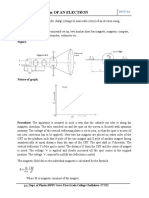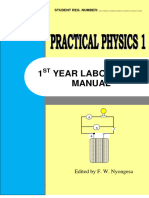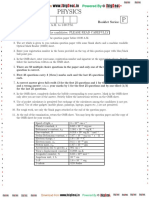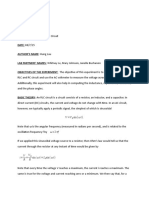Lissajous Figure
Lissajous Figure
Uploaded by
Sunil NamdevCopyright:
Available Formats
Lissajous Figure
Lissajous Figure
Uploaded by
Sunil NamdevOriginal Description:
Copyright
Available Formats
Share this document
Did you find this document useful?
Is this content inappropriate?
Copyright:
Available Formats
Lissajous Figure
Lissajous Figure
Uploaded by
Sunil NamdevCopyright:
Available Formats
Experiment No.
-
Aim- To study and calculate the phase difference between two waveforms using Lissajous Patterns on CRO.
Theory-
In mathematics a Lissajous curve also !nown as Lissajous figure or Bowditch curve "b a d t"
is the graph of a system of parametric e#uations
$hich describe comple% harmonic motion. This family of curves was investigated by &athaniel 'owditch in
()(* and later in more detail by +ules ,ntoine Lissajous in ()*-.
The appearance of the figure is highly sensitive to the ratio a"b. .or a ratio of ( the figure is an ellipse with
special cases including circles /A 0 B 0 1"2 radians3 and lines / 0 43. ,nother simple Lissajous figure is the
parabola /a"b 0 2 0 1"53. Other ratios produce more complicated curves which are closed only if a"b is rational.
The visual form of these curves is often suggestive of a three6dimensional !not and indeed many !inds of !nots
including those !nown as Lissajous !nots project to the plane as Lissajous figures.
7isually the ratio a"b determines the number of 8lobes8 of the figure. .or e%ample a ratio of 9"( or ("9 produces
a figure with three major lobes /see image3. :imilarly a ratio of *"5 produces a figure with * hori;ontal lobes and
5 vertical lobes. Rational ratios produce closed /connected3 or 8still8 figures while irrational ratios produce
figures that appear to rotate. The ratio A"B determines the relative width6to6height ratio of the curve. .or e%ample
a ratio of 2"( produces a figure that is twice as wide as it is high. .inally the value of determines the apparent
8rotation8 angle of the figure viewed as if it were actually a three6dimensional curve. .or e%ample 04 produces
x and y components that are e%actly in phase so the resulting figure appears as an apparent three6dimensional
figure viewed from straight on /4<3. In contrast any non6;ero produces a figure that appears to be rotated either
as a left"right or an up"down rotation /depending on the ratio a"b3.
Lissajous figure on an oscilloscope displaying a (=9 relationship between the fre#uencies of the vertical and
hori;ontal sinusoidal inputs respectively.
Lissajous figures where a 0 ( b 0 N /N is a natural number3 and
Generation
Prior to modern electronic e#uipment Lissajous curves could be generated mechanically by means of a
harmonograph.
Appication for the case of a ! b
In this figure both input fre#uencies are identical but the phase variance between them creates the shape of an
ellipse.
"rocedure-
(. .irstly connect two .unction >enerator with the Oscilloscope into channel ? @ A.
2. &ow switch on the ?6A Bode in the front panel of CRO.
9. ,pply both the waveforms respectively as following conditions.
5. Observe the Lissajous figures with !eeping the ratio of a 0 ( b 0 2 /(=23. &ow draw the pattern in a trace
paper and mention the parameters.
a 0 ( b 0 2 /(=23
*. Observe the Lissajous figures with !eeping the ratio of a 0 9 b 0 2 /9=23. &ow draw the pattern in a trace
paper and mention the parameters.
a 0 9 b 0 2 /9=23
C. Observe the Lissajous figures with !eeping the ratio of a 0 9 b 0 5 /9=53. &ow draw the pattern in a trace
paper and mention the parameters.
a 0 9 b 0 5 /9=53
-. Observe the Lissajous figures with !eeping the ratio of a 0 * b 0 5 /*=53. &ow draw the pattern in a trace
paper and mention the parameters.
a 0 * b 0 5 /*=53
"ractica appication
Lissajous curves can also be generated using an oscilloscope /as illustrated3. ,n octopus circuit can be used to
demonstrate the waveform images on an oscilloscope. Two phase6shifted sinusoid inputs are applied to the
oscilloscope in ?6A mode and the phase relationship between the signals is presented as a Lissajous figure.
In the professional audio world this method is used for real6time analysis of the phase relationship between the
left and right channels of a stereo audio signal. On larger more sophisticated audio mi%ing consoles an
oscilloscope may be built6in for this purpose.
On an oscilloscope we suppose x is CD( and y is CD2 A is amplitude of CD( and B is amplitude of CD2 a is
fre#uency of CD( and b is fre#uency of CD2 so a"b is a ratio of fre#uency of two channels finally is the phase
shift of CD(.
, purely mechanical application of a Lissajous curve with a0( b02 is in the driving mechanism of the Bars Light
type of oscillating beam lamps popular with rail6roads in the mid6(E44s. The beam in some versions traces out a
lopsided figure6) pattern with the 8)8 lying on its side.
Top= Input signal as a function of time Biddle= Output signal as a function of time. 'ottom= resulting Lissajous
curve when output is plotted as a function of the input. In this particular e%ample because the output is E4
degrees out of phase from the input the Lissajous curve is a circle.
, pure phase shift affects the eccentricity of the Lissajous oval. ,nalysis of the oval allows phase shift from an
LTI system to be measured.
#esut-
You might also like
- Solved Problems For Transient Electrical CircuitsNo ratings yetSolved Problems For Transient Electrical Circuits235 pages
- Experiment No. 05 Bi-Quartz Polarimeter: Prepared By: Department of Physics Medi-Caps University, IndoreNo ratings yetExperiment No. 05 Bi-Quartz Polarimeter: Prepared By: Department of Physics Medi-Caps University, Indore16 pages
- 7.GATE - Atomic and Molecular Physics Solution-2023No ratings yet7.GATE - Atomic and Molecular Physics Solution-20235 pages
- Sextant Deepalijainsgroup1 130219054351 Phpapp02No ratings yetSextant Deepalijainsgroup1 130219054351 Phpapp0221 pages
- Experiment 2-The Emitter-Follower Amplifier100% (1)Experiment 2-The Emitter-Follower Amplifier2 pages
- Experiment 2: Deterrnine The Surface Tension Ot Water by Capillary Rise MethodNo ratings yetExperiment 2: Deterrnine The Surface Tension Ot Water by Capillary Rise Method4 pages
- IO.5 Elliptically Polarized Light: 1. PurposeNo ratings yetIO.5 Elliptically Polarized Light: 1. Purpose5 pages
- Laser Beam Profile, Spot Size and Beam Divergence: Ravitej UppuNo ratings yetLaser Beam Profile, Spot Size and Beam Divergence: Ravitej Uppu3 pages
- PN Junction Diode Characteristics: Experiment No: 1No ratings yetPN Junction Diode Characteristics: Experiment No: 14 pages
- Vector Spaces: 1. Definition and ExamplesNo ratings yetVector Spaces: 1. Definition and Examples28 pages
- Meter Bridge Experiment Using Wheatstone Bridge Principle PDF100% (1)Meter Bridge Experiment Using Wheatstone Bridge Principle PDF12 pages
- Energy Band Gap of A Solid SemiconductorNo ratings yetEnergy Band Gap of A Solid Semiconductor6 pages
- Course No. 309 Experiment No. 3 Name of The Experiment: Determination of TheNo ratings yetCourse No. 309 Experiment No. 3 Name of The Experiment: Determination of The17 pages
- To Determine The Wavelength of Laser Light Using Single Slit Diffrac-Tion PatternNo ratings yetTo Determine The Wavelength of Laser Light Using Single Slit Diffrac-Tion Pattern8 pages
- 2.GATE - Classical Mechanics Solution-2023No ratings yet2.GATE - Classical Mechanics Solution-20233 pages
- PN Junction at Equilibrium.: Diffusion DriftNo ratings yetPN Junction at Equilibrium.: Diffusion Drift4 pages
- Statics of Rigid Bodies: Northern Iloilo State UniversityNo ratings yetStatics of Rigid Bodies: Northern Iloilo State University10 pages
- Automatic Control of Electrical Overhead Smart Trolley Crane AEOSTC Based Programmable Logic Controller (PLC)No ratings yetAutomatic Control of Electrical Overhead Smart Trolley Crane AEOSTC Based Programmable Logic Controller (PLC)10 pages
- Instant ebooks textbook Control of Machines Revised second edition Bhattacharya S. K. download all chaptersNo ratings yetInstant ebooks textbook Control of Machines Revised second edition Bhattacharya S. K. download all chapters55 pages
- Graphing The Voltage Across An LRC Circuit Using PythonNo ratings yetGraphing The Voltage Across An LRC Circuit Using Python10 pages
- TLP627, TLP627-2, TLP627-4: Programmable Controllers DC-output Module TelecommunicationNo ratings yetTLP627, TLP627-2, TLP627-4: Programmable Controllers DC-output Module Telecommunication9 pages
- Simulation of Power Electronics Circuits With MATLAB®/Simulink®: Design, Analyze, and Prototype Power Electronics 1st Edition Farzin AsadiNo ratings yetSimulation of Power Electronics Circuits With MATLAB®/Simulink®: Design, Analyze, and Prototype Power Electronics 1st Edition Farzin Asadi25 pages
- A Reference Guide To The Dell OptiPlex Diagnostic Indicators - Dell USNo ratings yetA Reference Guide To The Dell OptiPlex Diagnostic Indicators - Dell US22 pages
- Active Power Factor Correction Technique For Three-Phase Diode RectifiersNo ratings yetActive Power Factor Correction Technique For Three-Phase Diode Rectifiers10 pages
- L3Harris Falcon Iii® RF-7800M-MP: Wideband Networking Manpack Radio100% (1)L3Harris Falcon Iii® RF-7800M-MP: Wideband Networking Manpack Radio2 pages
- NPN Epitaxial Planar Transistor: Features: SOT-89No ratings yetNPN Epitaxial Planar Transistor: Features: SOT-893 pages
- SERV2075 - 03/16 Module 9 - ElectronicsNo ratings yetSERV2075 - 03/16 Module 9 - Electronics91 pages
- Very-Low-Speed Variable-Structure Control of Sensor Less Axial Flux Permanent Magnet Synchronous Motor Using An Advanced Rotor Flux ConceptNo ratings yetVery-Low-Speed Variable-Structure Control of Sensor Less Axial Flux Permanent Magnet Synchronous Motor Using An Advanced Rotor Flux Concept9 pages
- Control IC For Single-Ended and Push-Pull Switched-Mode Power Supplies (SMPS) TDA 4700 TDA 4718No ratings yetControl IC For Single-Ended and Push-Pull Switched-Mode Power Supplies (SMPS) TDA 4700 TDA 471821 pages
- Modern Electromagnetic Scattering Theory with ApplicationsFrom EverandModern Electromagnetic Scattering Theory with Applications
- Experiment No. 05 Bi-Quartz Polarimeter: Prepared By: Department of Physics Medi-Caps University, IndoreExperiment No. 05 Bi-Quartz Polarimeter: Prepared By: Department of Physics Medi-Caps University, Indore
- 7.GATE - Atomic and Molecular Physics Solution-20237.GATE - Atomic and Molecular Physics Solution-2023
- Experiment 2: Deterrnine The Surface Tension Ot Water by Capillary Rise MethodExperiment 2: Deterrnine The Surface Tension Ot Water by Capillary Rise Method
- Laser Beam Profile, Spot Size and Beam Divergence: Ravitej UppuLaser Beam Profile, Spot Size and Beam Divergence: Ravitej Uppu
- PN Junction Diode Characteristics: Experiment No: 1PN Junction Diode Characteristics: Experiment No: 1
- Meter Bridge Experiment Using Wheatstone Bridge Principle PDFMeter Bridge Experiment Using Wheatstone Bridge Principle PDF
- Course No. 309 Experiment No. 3 Name of The Experiment: Determination of TheCourse No. 309 Experiment No. 3 Name of The Experiment: Determination of The
- To Determine The Wavelength of Laser Light Using Single Slit Diffrac-Tion PatternTo Determine The Wavelength of Laser Light Using Single Slit Diffrac-Tion Pattern
- Statics of Rigid Bodies: Northern Iloilo State UniversityStatics of Rigid Bodies: Northern Iloilo State University
- Automatic Control of Electrical Overhead Smart Trolley Crane AEOSTC Based Programmable Logic Controller (PLC)Automatic Control of Electrical Overhead Smart Trolley Crane AEOSTC Based Programmable Logic Controller (PLC)
- Instant ebooks textbook Control of Machines Revised second edition Bhattacharya S. K. download all chaptersInstant ebooks textbook Control of Machines Revised second edition Bhattacharya S. K. download all chapters
- Graphing The Voltage Across An LRC Circuit Using PythonGraphing The Voltage Across An LRC Circuit Using Python
- TLP627, TLP627-2, TLP627-4: Programmable Controllers DC-output Module TelecommunicationTLP627, TLP627-2, TLP627-4: Programmable Controllers DC-output Module Telecommunication
- Simulation of Power Electronics Circuits With MATLAB®/Simulink®: Design, Analyze, and Prototype Power Electronics 1st Edition Farzin AsadiSimulation of Power Electronics Circuits With MATLAB®/Simulink®: Design, Analyze, and Prototype Power Electronics 1st Edition Farzin Asadi
- A Reference Guide To The Dell OptiPlex Diagnostic Indicators - Dell USA Reference Guide To The Dell OptiPlex Diagnostic Indicators - Dell US
- Active Power Factor Correction Technique For Three-Phase Diode RectifiersActive Power Factor Correction Technique For Three-Phase Diode Rectifiers
- L3Harris Falcon Iii® RF-7800M-MP: Wideband Networking Manpack RadioL3Harris Falcon Iii® RF-7800M-MP: Wideband Networking Manpack Radio
- Very-Low-Speed Variable-Structure Control of Sensor Less Axial Flux Permanent Magnet Synchronous Motor Using An Advanced Rotor Flux ConceptVery-Low-Speed Variable-Structure Control of Sensor Less Axial Flux Permanent Magnet Synchronous Motor Using An Advanced Rotor Flux Concept
- Control IC For Single-Ended and Push-Pull Switched-Mode Power Supplies (SMPS) TDA 4700 TDA 4718Control IC For Single-Ended and Push-Pull Switched-Mode Power Supplies (SMPS) TDA 4700 TDA 4718





























































































